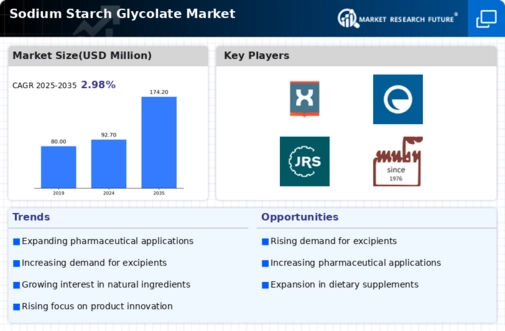Top Industry Leaders in the Sodium Starch Glycolate Market
 Beyond the gleaming shelves of pharmacies and the smooth glide of a pill down your throat lies a hidden hero – the Sodium Starch Glycolate (SSG) market. These seemingly simple yet critical starches play a vital role in modern pharmaceuticals, ensuring medication disintegrates quickly and releases its active ingredients effectively. But beneath the seemingly uniform layer of white powder lies a dynamic battlefield where established giants and agile startups grapple for market share amidst evolving trends, technological advancements, and stringent regulations. Let's delve deeper into the strategies, factors, and recent developments shaping this transformative market.
Beyond the gleaming shelves of pharmacies and the smooth glide of a pill down your throat lies a hidden hero – the Sodium Starch Glycolate (SSG) market. These seemingly simple yet critical starches play a vital role in modern pharmaceuticals, ensuring medication disintegrates quickly and releases its active ingredients effectively. But beneath the seemingly uniform layer of white powder lies a dynamic battlefield where established giants and agile startups grapple for market share amidst evolving trends, technological advancements, and stringent regulations. Let's delve deeper into the strategies, factors, and recent developments shaping this transformative market.
Strategies Dissolving Competition:
-
Product Diversification: Leading players like Roquette, JRS Pharma, and BASF are constantly refining their offerings, developing customized SSG grades with tailored properties for specific pharmaceuticals. Think high-dispersing grades for rapid disintegration, high-compression grades for chewable tablets, and acid-resistant grades for enteric-coated medications. -
Sustainability Focus: Environmental consciousness is influencing the market. Players are adopting energy-efficient production processes, exploring non-GMO starch sources, and developing dust-free manufacturing techniques to minimize environmental impact and cater to eco-conscious pharmaceutical companies. -
Regulatory Compliance: Stringent regulations like FDA and EMA compliance require strict quality control and documentation. Companies meeting these standards gain a competitive edge and ensure patient safety. -
Geographical Expansion: Emerging economies in Asia and South America present immense growth potential, driven by expanding pharmaceutical production and rising healthcare spending. Companies like A.C.C. Ltd. and Shandong Yifan Biochem are establishing production facilities and forging partnerships in these regions to capitalize on this trend.
Factors Fueling Market Growth:
-
Pharmaceutical Industry Boom: The growing global demand for pharmaceuticals, driven by an aging population and increasing chronic diseases, fuels the need for effective disintegrants like SSG. -
Novel Drug Delivery Systems: The rise of complex drug delivery systems like oral dispersible tablets and fast-acting sublingual medications requires specialized SSG grades for efficient dispersion and absorption. -
Technological Advancements: Research and development efforts are leading to improved manufacturing techniques, the development of novel starch modifications, and the exploration of alternative disintegrants with enhanced properties. Early adopters and innovators stand to benefit significantly from these advancements. -
Cost-Effectiveness: Compared to other disintegrants, SSG offers superior performance at a competitive price point, making it a preferred choice for cost-conscious pharmaceutical manufacturers.
Key Players
- DFE Pharma (Germany)
- Roquette (French)
- Shree Chemicals (India)
- Prachin Chemical (India)
- NB Entrepreneurs (India)
- Spectrum Chemical Manufacturing Corp. (U.S.)
- H.P. Chemicals (India)
- Remedy labs (India)
- JRS PHARMA (Germany)
- Muby Chemicals (India).
Recent Developments
-
September 2023: The US FDA proposes stricter regulations on the manufacturing and testing of pharmaceutical excipients, pushing for enhanced quality control and documentation within the SSG market. -
October 2023: Roquette unveils a new line of biodegradable SSG products made from sustainable sources, catering to eco-conscious pharmaceutical companies and reducing environmental impact. -
November 2023: A consortium of leading pharmaceutical companies, research institutions, and SSG manufacturers launches a collaborative project to develop standardized protocols for characterizing and qualifying new SSG grades, aiming to optimize drug formulation development. -
December 2023: The Sodium Starch Glycolate market exhibits cautious optimism for continued growth in 2024, driven by rising pharmaceutical production, technological advancements, and a focus on sustainability and regulatory compliance. However, uncertainties in raw material availability and evolving regulations require careful monitoring.

